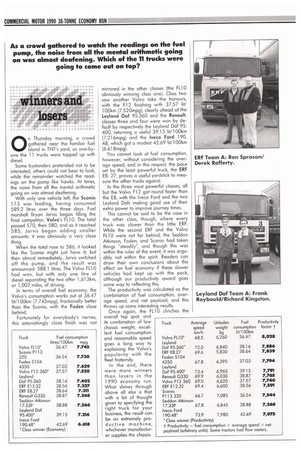As a crowd gathered to watch the readings on the
Page 78

If you've noticed an error in this article please click here to report it so we can fix it.
fuel pump, the noise from all the mental arithmetic going on was almost deafening. Which of the TI trucks were going to come out on top?
0n Thursday morning, a crowd gathered near the familiar fuel island in TNT's yard, as one-byone the 11 trucks were topped up with diesel.
Some bystanders pretended not to be interested, others could not bear to look, while the remainder watched the readings on the pump like hawks. At times, the noise from all the mental arithmetic going on was almost deafening.
With only one vehicle left, the Scania 113 was leading, having consumed 589.2 litres over the three days. Fuel marshal! Bryan Jarvis began filling the final competitor, Volvo's FL] O. The total passed 570, then 580, and as it reached 585, Jarvis began adding smaller amounts: it was obviously a very close thing.
When the total rose to 586, it looked like the Scania might just have it; but then almost immediately, Jarvis switched off the pump, and the result was announced: 588.1 litres. The Volvo FLI 0 had won, but with only one litre of diesel separating the two after 1,613km, or 1,002 miles, of driving.
In terms of overall fuel economy, the Volvo's consumption works out at 36.47 lit/100km (7.745mpg), fractionally better than the Scania, with the Foden close behind.
Fortunately for everybody's nerves, this astonishingly close finish was not mirrored in the other classes (the FL10 obviously winning class one). Class two saw another Volvo take the honours, with the F12 finishing with 37.57 lit/ 100km (7.520mpg), clearly ahead of the Leyland Daf 95.360 and the Renault; classes three and four were won by default by respectively the Leyland Daf 95. 400, returning a useful 39.15 lit/100km (7.216mpg) and the Iveco Ford 190. 48, which got a modest 42.69 lit/100km (6.618mpg).
You cannot look at fuel consumption, however, without considering the average speed, and in this respect, the pace set by the least powerful truck, the ERF E8. 27, proves a useful yardstick to measure the other trucks against.
In the three most powerful classes, all but the Volvo F12 got round faster than the E8, with the Iveco Ford and the two Leyland Dafs making good use of their extra power to improve journey times.
This cannot be said to be the case in the other class, though, where every truck was slower than the little ERF. While the second ERF and the Volvo FLI 0 were not far behind, the Seddon Atkinson, Foden, and Scania had taken things "steadily", and though this was within the rules of the event, it was arguably not within the spirit. Readers can draw their own conclusions about the effect on fuel economy if these slower vehicles had kept up with the pack, although our productivity award goes some way to reflecting this.
The productivity was calculated as the combination of fuel consumption, average speed, and net payload, and this throws up some interesting results.
Once again, the FLIO clinches the overall top spot, and its combination of low chassis weight, excellent fuel consumption and reasonable speed goes a long way to explaining the Volvo's popularity with the fleet fraternity.
In the end, there were more winners than losers in the 1 990 economy run. What shines through above all else is that with a bit of thought given to specifying the right truck for your business, the result can be an extremely productive machine, whichever manufacturer supplies the chassis.






















































































































































































